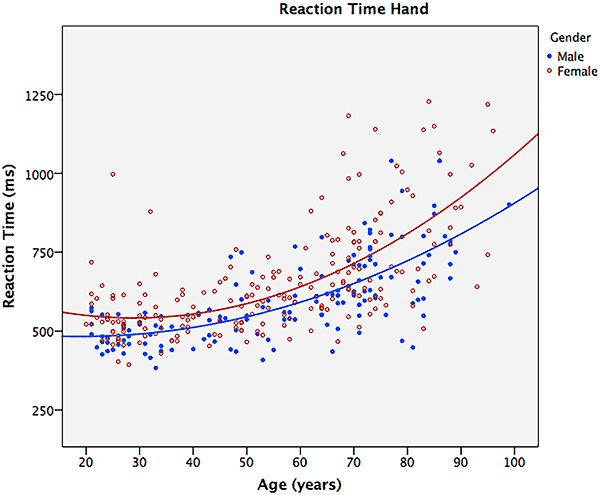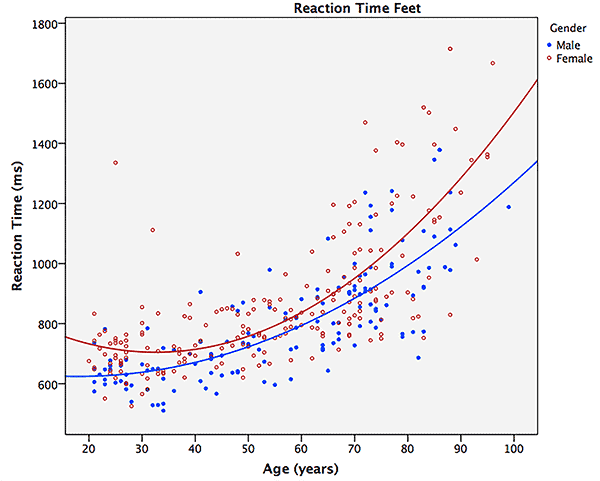Reaction time test to find out how fast you really are. A human benchmark test which helps you to measure your simple reaction time. We also have lots of tips & tricks on how to become faster.
Reaction Time Test
Click to start
When the red box turns green,
click as quickly as possible
What is human reaction time?
The simple definition of the human reaction time is the time that elapses between a stimulus and responds to that stimulus. For example, the time passes between the traffic lights turn red in front you and then you hit the brake pedal to slow down and stop as soon as possible. According to J.Y. Fang, T.L. Davis, in Reference Module in Neuroscience and Biobehavioral Psychology, there are 3 basic types of response times.
1. Single reaction time has a single stimulus with a single predefined response. For example, our test is a single reaction time test because there is only one stimulus (something changes its colours) and also one and only predefined response (click when this change happens).
2. Recognition reaction time has several false stimuli mixed with one correct stimulus prompting the response
3. Choice reaction time involves multiple stimuli and differing responses for each stimulus.
How does the human benchmark reaction time test works?
This is a simple reaction time test where you have to wait to the box colour changes from red to green (just like in the everyday traffic). We measure the time elapsed between the stimulus (light changes from red to green) and your motor response to the stimulus (you click on the box when it’s green). After the successful measurement, we display your reaction time in milliseconds (1 second is equal to 1000 millisecond).
What is the average reaction time?
The simple average reaction time is around 250 milliseconds. This is for visual stimulus like in our test where the fastest reaction time is around 150 milliseconds and the slowest is about 450 milliseconds. The reaction time during an unconscious action like reflex is much faster, around 80 milliseconds. This is because reflex is automatic, your brain doesn’t involve in this decision and motor movement.
One more thing you should know about the result is that computers/laptops have a lag time around 25-35 ms and the touch screen has even more.
To evaluate your results here is a human benchmark reaction time chart:
| REACTION TIME VALUE | EVALUATION |
| below 125 ms | Are you really a human or a robot? |
| 125 – 175 ms | Extremely fast. |
| 175 – 225 ms | Faster than the average. |
| 225 – 275 ms | Around average. |
| 275 – 325 ms | Slightly slower than average. |
| 325 – 375 ms | Much slower than average. |
| 375 – 425 ms | It seems very slow. |
| above 425 ms | Are you really listening? |
How to improve reaction time?
Fast reaction time is important in many ways when you drive your car or playing Fortnite. Here are some tips on how you can improve your reaction time:
1. Practice a lot. If you want to improve in a certain activity you should practise it a lot whether it’s a video game or sports activity like baseball, where players can dive to catch a sizzling line drive. Remember, if you don’t use it, you’ll lose it.
2. Learn new things, challenge your brain. Cognitive exercises can help a lot to improve your reaction time by strengthening the brain neurons and decrease the brain’s response time. It’s like going to the gym but instead of building your muscles, you train your brain.
3. Warm-up. If you warm up your muscles, your motor response is going to be faster. Warming up before any kind of exercise is always a good thing to do.
4. Healthy food. A healthy diet has a good effect on brain function. And perhaps we don’t have to say that e.g. alcohol consumption significantly impairs reaction time for up to several hours.
5. Meditation. Regular meditation is another healthy way to improve your reaction time. Of course, Yoga and other similar meditation techniques have a number of additional benefits.
Reaction time by age
You probably already guess that reaction time increases with age. This is primarily due to impaired or reduced cognitive functioning which is absolutely normal although we are not happy about it. If you are getting older you should consider the tips and tricks mentioned above for improving your reaction time.
Below you can see the result of a reaction time and ageing study where healthy participants were recruited and their reaction time was tested by using the Nintendo Wii Balance Board. Reference data were analyzed and presented in age-groups, while the age-related change in reaction time was tested.
354 participants between 20 and 99 years of age were tested. There was a statistically significant non-linear increase in reaction time with age. The averaged difference between male and female was significant, with males being faster than females for both hands and feet.
Reference data on reaction time and ageing using the Nintendo Wii Balance Board: A cross-sectional study of 354 subjects from 20 to 99 years of age


